Analysis of Leakage in a Sustainable Water Pipeline Based on a Magnetic Flux Leakage Technique
Abstract
1. Introduction
| Serial Number | Defect Type | Defect Depth | Wall Thickness | SNR (dB) | Reference |
|---|---|---|---|---|---|
| 1 | Surface hole | 2.5 | 4.83 | 8–12 | [22] |
| 2 | Surface rectangular | 10 | 15 | 6 | [33] |
| 3 | Subsurface rectangular | 1.72 | 12 | 11.6 | [34] |
| 4 | Surface erosion | 1 | 6.3 | 9 | [35] |
| 5 | Surface notch | 1 | 6.3 | 12 | [35] |
| 6 | Subsurface hole | 2 | 6.3 | 7 | [35] |
| 7 | Subsurface rectangular | 5.76 | 12 | 11.13 | [39] |
| 8 | Subsurface rectangular | 3.32 | 12 | 5.64 | [39] |
| 9 | Surface holes | 2–8 | 10 | 1.5–13% | [17] |
2. Robot Configuration
3. Experimental Study
4. Results and Discussion
4.1. Analysis of the Different through-Hole Axial Sizes in the Non-Uniform Pipe
4.2. Analysis of LMA Defects in the Non-Uniform Pipe
4.3. Analysis of Uneven Multi Holes Defects in the Non-Uniform Pipe
5. Conclusions
Author Contributions
Funding
Institutional Review Board Statement
Informed Consent Statement
Data Availability Statement
Acknowledgments
Conflicts of Interest
References
- Yazdekhasti, S.; Piratla, K.R.; Sorber, J.; Atamturktur, S.; Khan, A.; Shukla, H. Sustainability analysis of a leakage-monitoring technique for water pipeline networks. J. Pipeline Syst. Eng. Pract. 2020, 11, 04019052. [Google Scholar] [CrossRef]
- Ali, S.; Hawwa, M.A.; Baroudi, U. Effect of Leak Geometry on Water Characteristics Inside Pipes. Sustainability 2022, 14, 5224. [Google Scholar] [CrossRef]
- Zhang, J.; Lian, Z.; Zhou, Z.; Song, Z.; Liu, M.; Yang, K. Leakage detection in a buried gas pipeline based on distributed optical fiber time-domain acoustic wave signal. Eng. Fail. Anal. 2022, 141, 106594. [Google Scholar] [CrossRef]
- Sekhavati, J.; Hashemabadi, S.H.; Soroush, M. Computational methods for pipeline leakage detection and localization: A review and comparative study. J. Loss Prev. Process Ind. 2022, 77, 104771. [Google Scholar] [CrossRef]
- Akram, M.R.; Can Zülfikar, A. Identification of Factors Influencing Sustainability of Buried Continuous Pipelines. Sustainability 2020, 12, 960. [Google Scholar] [CrossRef]
- Colombo, A.F.; Karney, B.W. Energy and costs of leaky pipes: Toward comprehensive picture. J. Water Resour. Plan. Manag.-ASCE 2002, 128, 441–450. [Google Scholar] [CrossRef]
- Zhu, J.; Collins, R.P.; Boxall, J.B.; Mills, R.S.; Dwyer-Joyce, R. Non-destructive in-situ condition assessment of plastic pipe using ultrasound. Procedia Eng. 2015, 119, 148–157. [Google Scholar] [CrossRef]
- Rifai, D.; Abdalla, A.N.; Razali, R.; Ali, K.; Faraj, M.A. An eddy current testing platform system for pipe defect inspection based on an optimized eddy current technique probe design. Sensors 2017, 17, 579. [Google Scholar] [CrossRef]
- Rodríguez-Olivares, N.A.; Cruz-Cruz, J.V.; Gómez-Hernández, A.; Hernández-Alvarado, R.; Nava-Balanzar, L.; Salgado-Jiménez, T.; Soto-Cajiga, J.A. Improvement of ultrasonic pulse generator for automatic pipeline inspection. Sensors 2018, 18, 2950. [Google Scholar] [CrossRef]
- Prakash, S.; Sharma, B.K.; Prakash, C.; Saini, S.; Sharma, A. Investigation of the Criticality of Flux Leakage of a Magnetizer Assembly of a MFL Tool for Oil and Gas Pipelines Inspection. In Advances in Production and Industrial Engineering; Springer: Singapore, 2021; pp. 323–333. [Google Scholar] [CrossRef]
- Ma, Q.; Tian, G.; Zeng, Y.; Li, R.; Song, H.; Wang, Z.; Gao, B.; Zeng, K. Pipeline in-line inspection method, instrumentation and data management. Sensors 2021, 21, 3862. [Google Scholar] [CrossRef]
- Coramik, M.; Ege, Y. Discontinuity inspection in pipelines: A comparison review. Measurement 2017, 111, 359–373. [Google Scholar] [CrossRef]
- Gupta, M.; Khan, M.A.; Butola, R.; Singari, R.M. Advances in applications of Non-Destructive Testing (NDT): A review. Adv. Mater. Process. Technol. 2021, 1–22. [Google Scholar] [CrossRef]
- Mostafapour, A.; Davoudi, S. Analysis of leakage in high pressure pipe using acoustic emission method. Appl. Acoust. 2013, 74, 335–342. [Google Scholar] [CrossRef]
- Zhang, Y.; Yan, G. Detection of gas pipe wall thickness based on electromagnetic flux leakage. Russ. J. Nondestr. Test. 2007, 43, 123–132. [Google Scholar] [CrossRef]
- Peng, X.; Anyaoha, U.; Liu, Z.; Tsukada, K. Analysis of magnetic-flux leakage (MFL) data for pipeline corrosion assessment. IEEE Trans. Magn. 2020, 56, 1–15. [Google Scholar] [CrossRef]
- Durai, M.; Lin, Z.-Q.; Lan, C.-W.; Chang, H.; Peng, C.-C. Study of Defects in the Petrochemical Storage Tank Floor using the Magnetic Flux Leakage (MFL) Technique. J. Fail. Anal. Prev. 2022, 22, 807–814. [Google Scholar] [CrossRef]
- Chen, L.; Que, P.-W.; Jin, T. A giant-magnetoresistance sensor for magnetic-flux-leakage nondestructive testing of a pipeline. Russ. J. Nondestr. Test. 2005, 41, 462–465. [Google Scholar] [CrossRef]
- Wu, D.; Liu, Z.; Wang, X.; Su, L. Composite magnetic flux leakage detection method for pipelines using alternating magnetic field excitation. NDTE Int. 2017, 91, 148–155. [Google Scholar] [CrossRef]
- Le, M.; Lee, J.; Jun, J.; Kim, J.; Moh, S.; Shin, K. Hall sensor array based validation of estimation of crack size in metals using magnetic dipole models. NDTE Int. 2013, 53, 18–25. [Google Scholar] [CrossRef]
- Gao, Y.; Tian, G.Y.; Li, K.; Ji, J.; Wang, P.; Wang, H. Multiple cracks detection and visualization using magnetic flux leakage and eddy current pulsed thermography. Sens. Actuators A 2015, 234, 269–281. [Google Scholar] [CrossRef]
- Li, Z.; Jarvis, R.; Nagy, P.B.; Dixon, S.; Cawley, P. Experimental and simulation methods to study the Magnetic Tomography Method (MTM) for pipe defect detection. NDTE Int. 2017, 92, 59–66. [Google Scholar] [CrossRef]
- Tehranchi, M.M.; Ranjbaran, M.; Eftekhari, H. Double core giant magneto-impedance sensors for the inspection of magnetic flux leakage from metal surface cracks. Sens. Actuators A 2011, 170, 55–61. [Google Scholar] [CrossRef]
- Park, J.; Park, J.; Song, S.; Kishore, M.; Kwon, S.; Kim, H. Enhanced detection of defects using GMR sensor based remote field eddy current technique. J. Magn. 2017, 22, 531–538. [Google Scholar] [CrossRef]
- Cubells-Beltrán, M.-D.; Reig, C.; Madrenas, J.; De Marcellis, A.; Santos, J.; Cardoso, S.; Freitas, P.P. Integration of GMR sensors with different technologies. Sensors 2016, 16, 939. [Google Scholar] [CrossRef]
- Botros, K.; Golshan, H. Field validation of a dynamic model for an MFL ILI tool in gas pipelines. In Proceedings of the International Pipeline Conference, Calgary, AB, Canada, 1 January 2010; pp. 325–336. [Google Scholar]
- Henry, R.; Chablat, D.; Porez, M.; Boyer, F.; Kanaan, D. Multi-objective design optimization of the leg mechanism for a piping inspection robot. In Proceedings of the International Design Engineering Technical Conferences and Computers and Information in Engineering Conference, Buffalo, NY, USA, 17 August 2014; p. V05AT08A001. [Google Scholar]
- Chablat, D.; Venkateswaran, S.; Boyer, F. Mechanical design optimization of a piping inspection robot. Procedia Cirp 2018, 70, 307–312. [Google Scholar] [CrossRef]
- Verma, A.; Kaiwart, A.; Dubey, N.D.; Naseer, F.; Pradhan, S. A review on various types of in-pipe inspection robot. Mater. Today Proc. 2022, 50, 1425–1434. [Google Scholar] [CrossRef]
- Kikuchi, H.; Sato, K.; Shimizu, I.; Kamada, Y.; Kobayashi, S. Feasibility study of application of MFL to monitoring of wall thinning under reinforcing plates in nuclear power plants. IEEE Trans. Magn. 2011, 47, 3963–3966. [Google Scholar] [CrossRef]
- Kikuchi, H.; Shimizu, I.; Ara, K.; Kamada, Y.; Kobayashi, S. Applicability of magnetic flux leakage method for wall thinning monitoring in nuclear power plants. In Electromagnetic Nondestructive Evaluation (XIV); IOS Press: Amsterdam, The Netherlands, 2011; Volume 35, pp. 275–281. [Google Scholar] [CrossRef]
- Pelkner, M.; Pohl, R.; Kreutzbruck, M.; Commandeur, C. Development of adapted GMR-probes for automated detection of hidden defects in thin steel sheets. AIP Conf. Proc. 2016, 1706, 020018. [Google Scholar] [CrossRef]
- Piao, G.; Guo, J.; Hu, T.; Leung, H. The effect of motion-induced eddy current on high-speed magnetic flux leakage (MFL) inspection for thick-wall steel pipe. Res. Nondestruct. Eval. 2020, 31, 48–67. [Google Scholar] [CrossRef]
- Singh, W.S.; Rao, B.; Mukhopadhyay, C.; Jayakumar, T. Finite element model-based approach for magnetic flux leakage testing of steel plates using 2D tandem GMR array sensors. Insight-Non-Destr. Test. Cond. Monit. 2014, 56, 683–690. [Google Scholar] [CrossRef]
- Singh, W.S.; Rao, B.P.; Mukhopadhyay, C.; Jayakumar, T. Detection of localized damage in water wall tubes of thermal power plants using GMR sensor array based magnetic flux leakage technique. J. Nondestruct Eval. 2015, 34, 1–7. [Google Scholar] [CrossRef]
- Ma, Y.; He, R.; Chen, J. A method for improving SNR of drill pipe leakage flux testing signals by means of magnetic concentrating effect. IEEE Trans. Magn. 2015, 51, 1–7. [Google Scholar] [CrossRef]
- Vértesy, G.; Gasparics, A.; Tomáš, I. Inspection of local wall thinning by different magnetic methods. J. Nondestruct. Eval. 2018, 37, 1–8. [Google Scholar] [CrossRef]
- Durai, M.; Lan, C.-W.; Chang, H. In-line detection of defects in steel pipes using flexible GMR sensor array. J. King Saud Univ. Sci. 2022, 34, 101761. [Google Scholar] [CrossRef]
- Singh, W.S.; Rao, B.; Sasi, B.; Vaidyanathan, S.; Jayakumar, T.; Raj, B. Giant Magneto-Resistive (GMR) Sensors for Non-Destructive Detection of Magnetic Flux Leakage from Sub-Surface Defects in Steels. In Proceedings of the International Conference on Sensors and Related Networks (SENNET-2009), VIT University, Vellore, India, 1 December 2009; Available online: https://www.researchgate.net/publication/258997959 (accessed on 15 September 2022).
- Tymrak, B.; Kreiger, M.; Pearce, J.M. Mechanical properties of components fabricated with open-source 3-D printers under realistic environmental conditions. Mater. Des. 2014, 58, 242–246. [Google Scholar] [CrossRef]
- Kreutzbruck, M.; Neubauer, A.; Pelkner, M.; Reimund, V. Adapted gmr array used in magnetic flux leakage inspection. In Proceedings of the 18th World Conference on Nondestructive Testing, Durban, South Africa, 16–20 April 2012; Available online: http://www.ndt.net/article/wcndt2012/papers/498_wcndtfinal00498.pdf (accessed on 15 September 2022).
- Liu, Z.; Ren, L. Shaking Noise Exploration and Elimination for Detecting Local Flaws of Steel Wire Ropes Based on Magnetic Flux Leakages. IEEE Trans. Ind. Electron. 2022. [Google Scholar] [CrossRef]
- Fedorov, D.; Ivoilov, A.Y.; Zhmud, V.; Trubin, V. Using of measuring system MPU6050 for the determination of the angular velocities and linear accelerations. Autom. Softw. Enginery 2015, 11, 75–80. [Google Scholar]
- Liu, Z.; Kang, Y.; Wu, X.; Yang, S. Study on local magnetization of magnetic flux leakage testing for storage tank floors. Insight 2003, 45, 328–331. [Google Scholar] [CrossRef]
- Meriem-Benziane, M.; Bou-Saïd, B.; Boudouani, N. The effect of crude oil in the pipeline corrosion by the naphthenic acid and the sulfur: A numerical approach. J. Pet. Sci. Eng. 2017, 158, 672–679. [Google Scholar] [CrossRef]
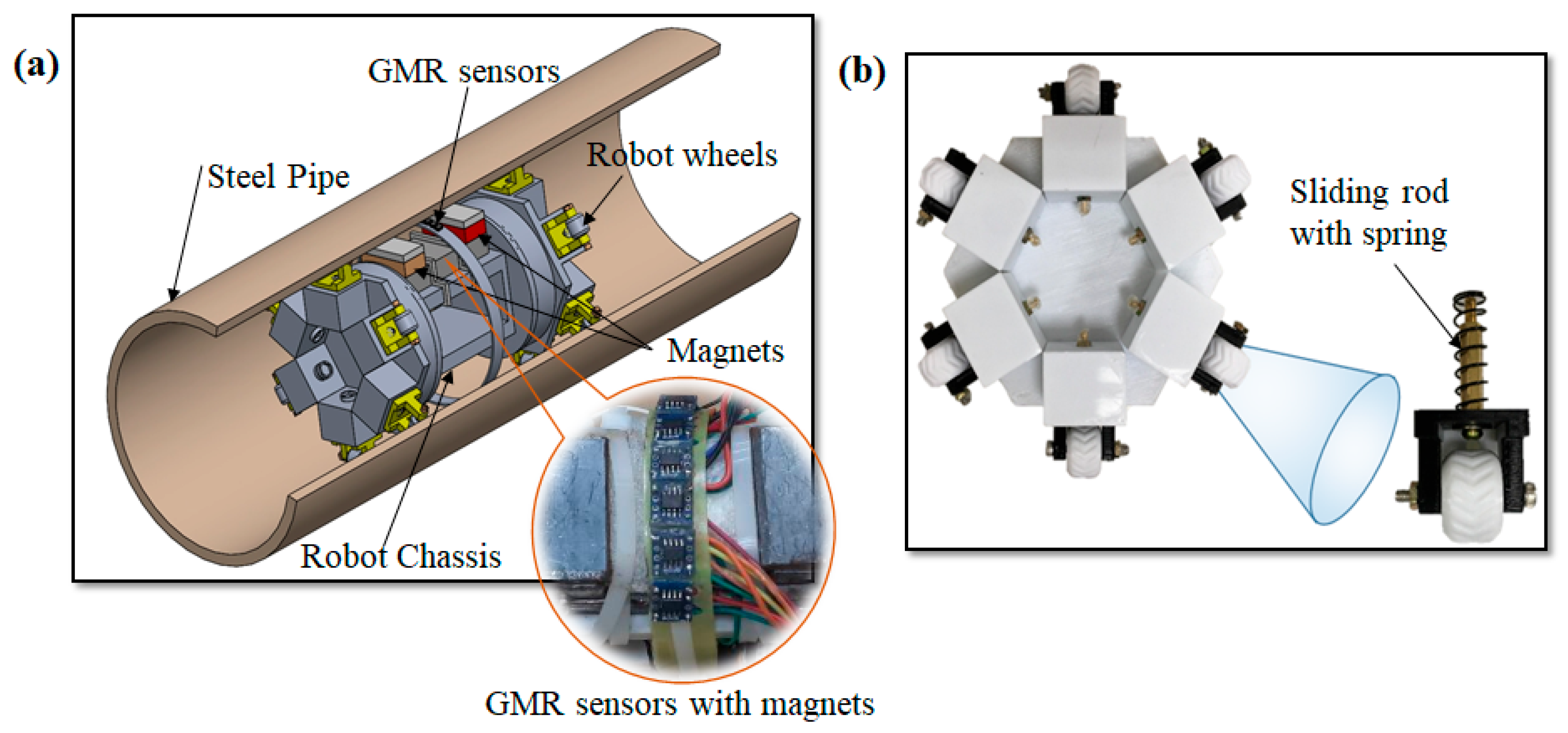
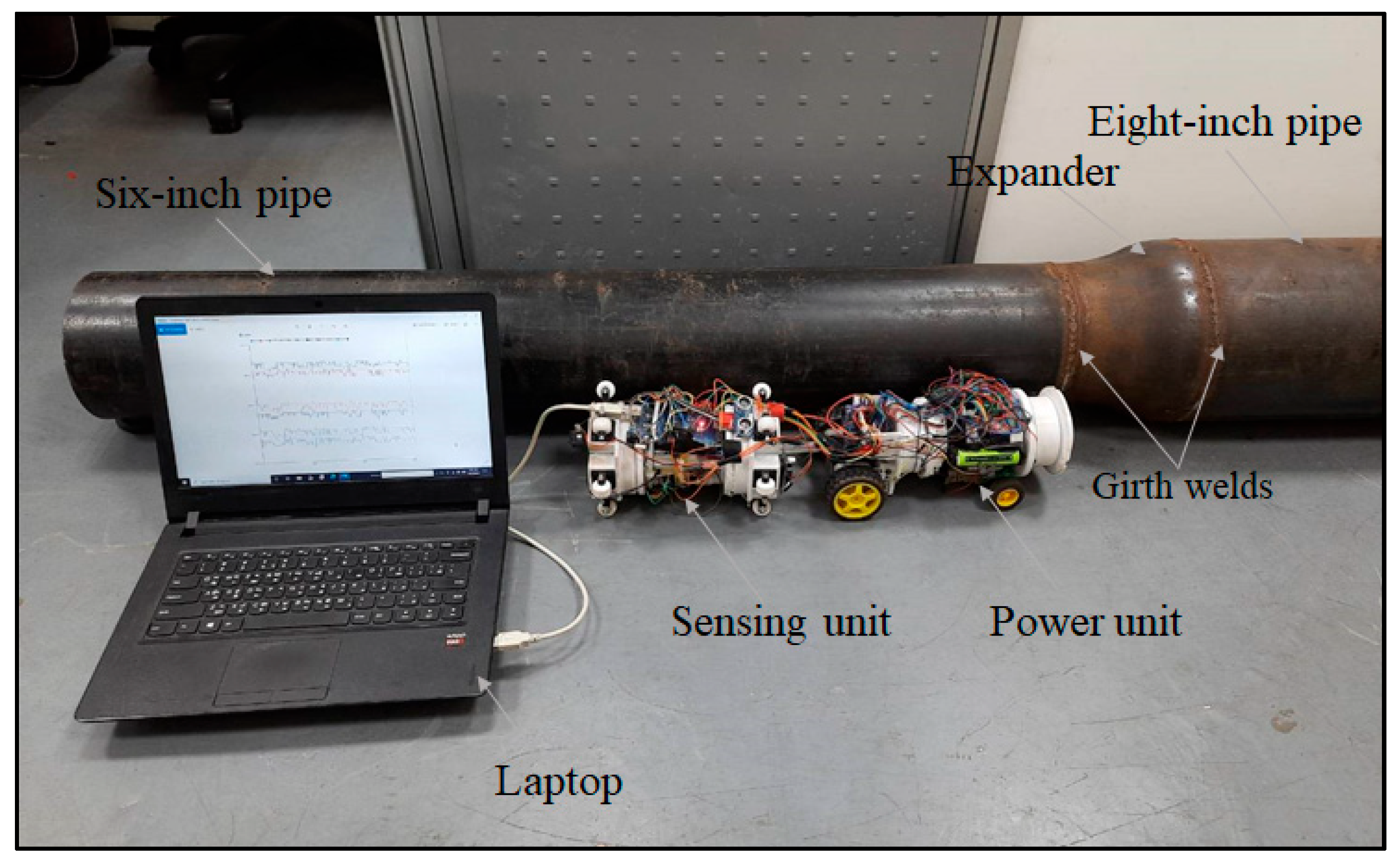
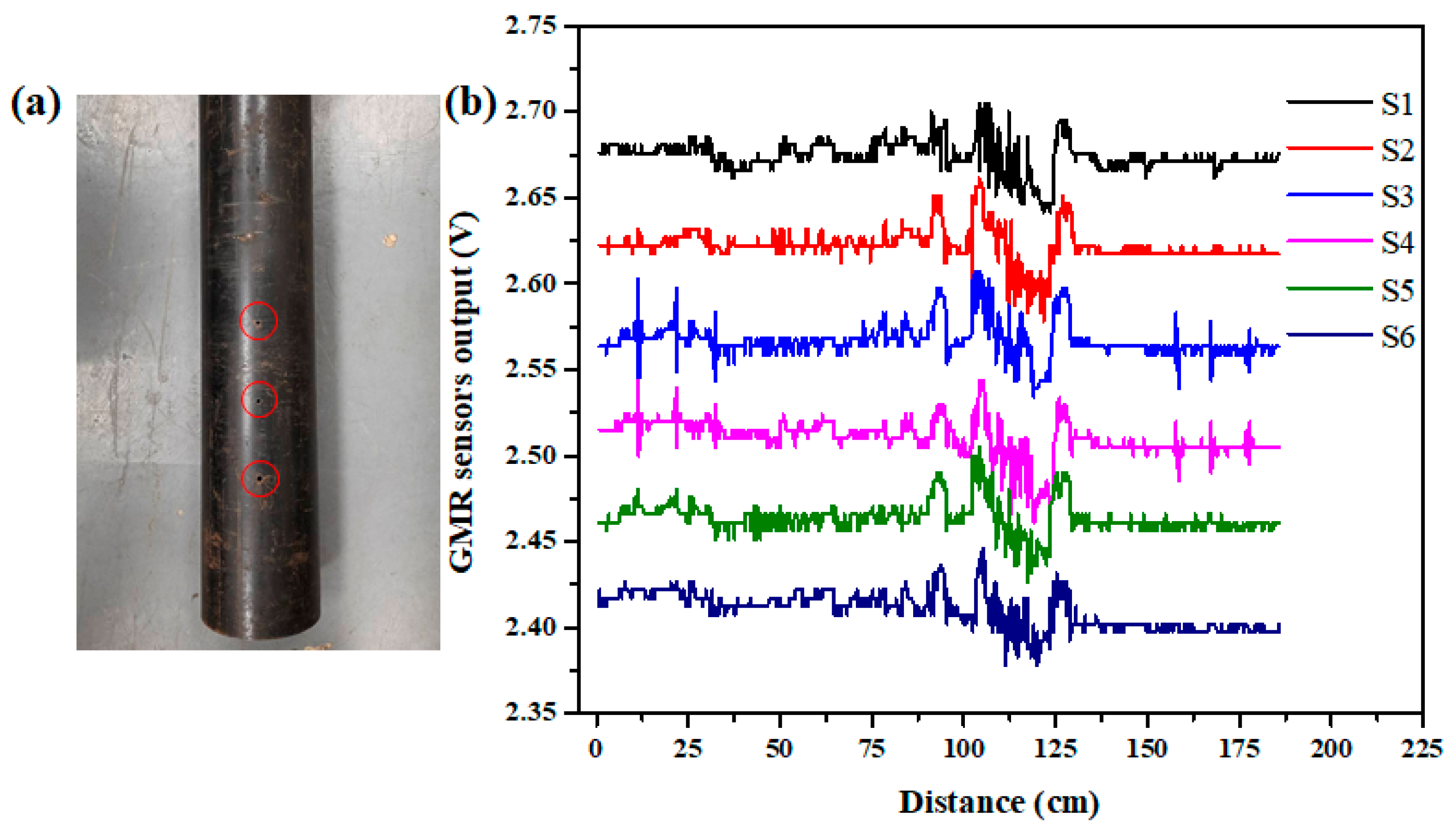
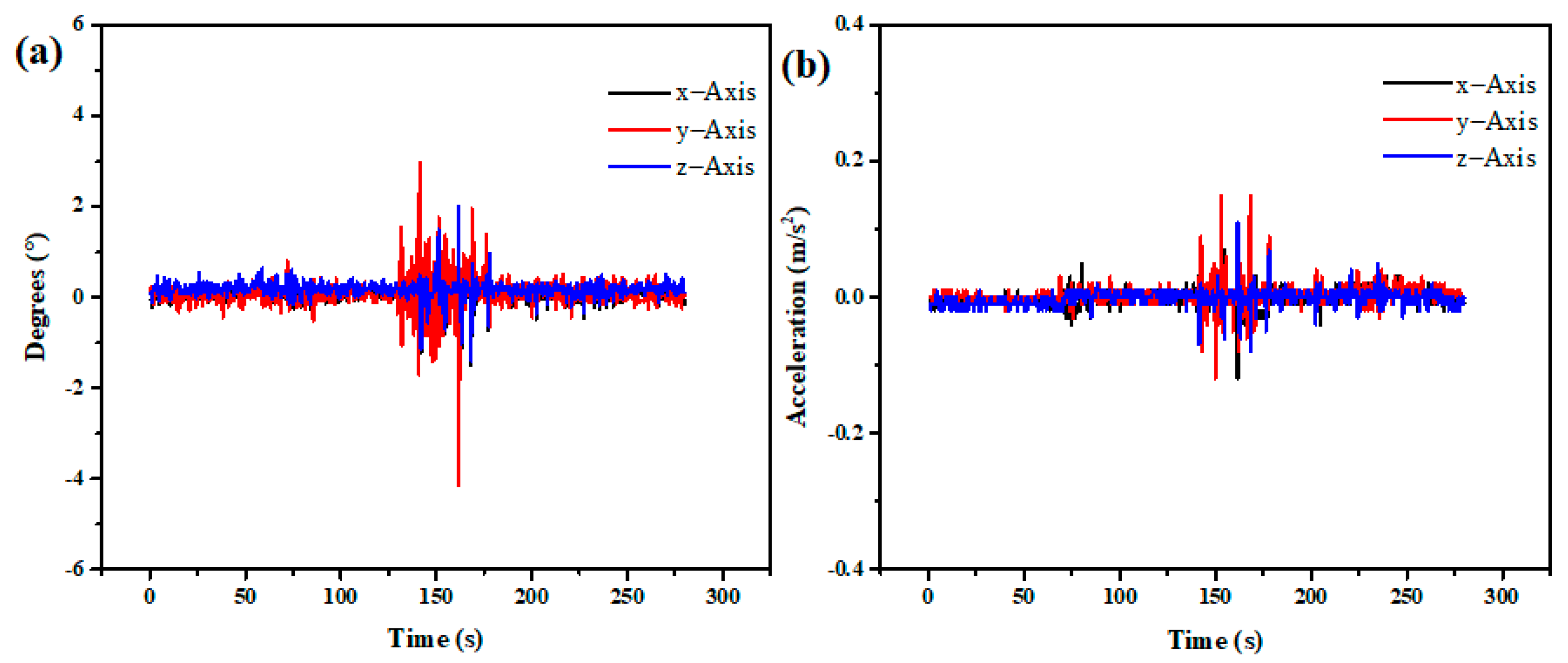
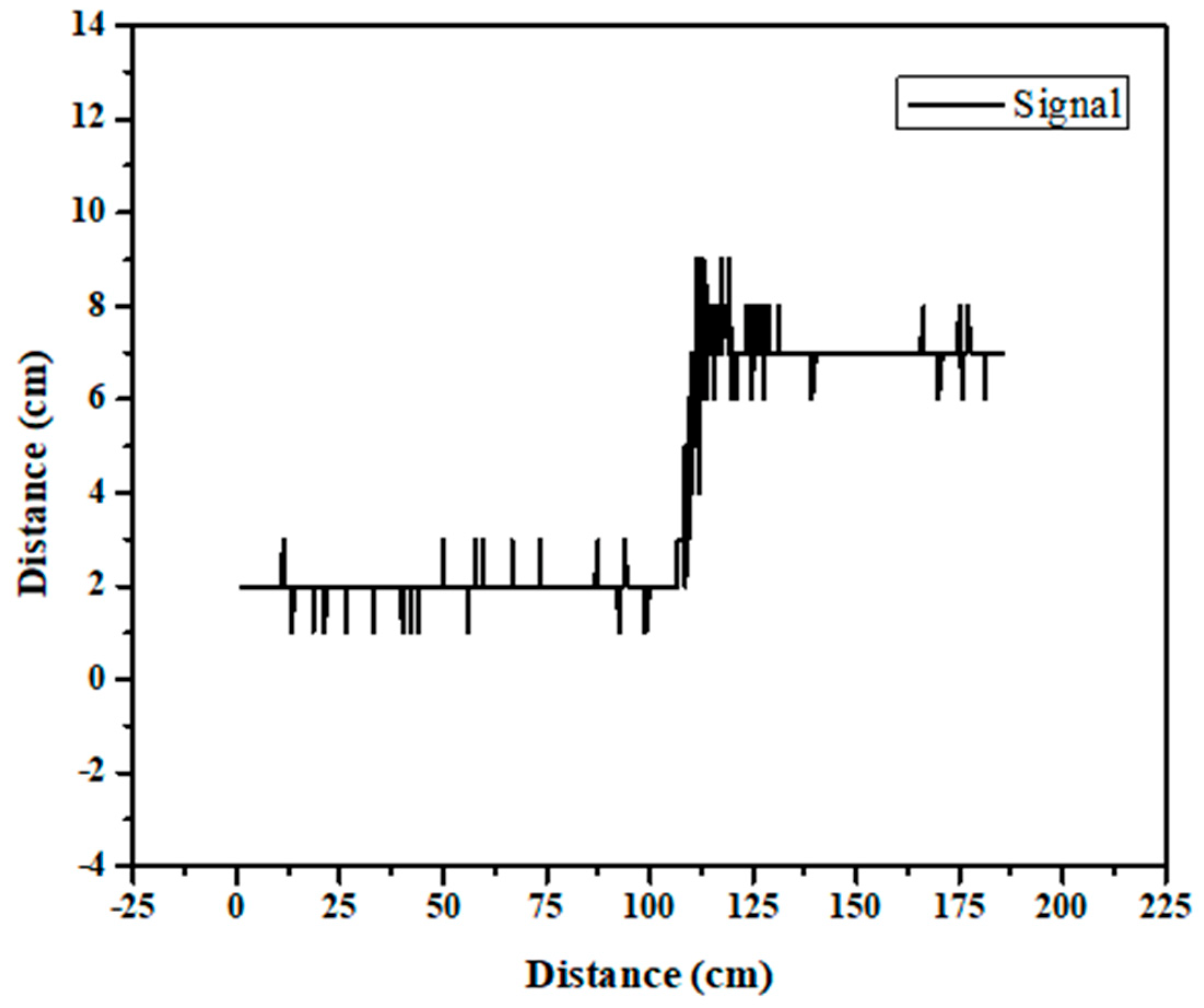
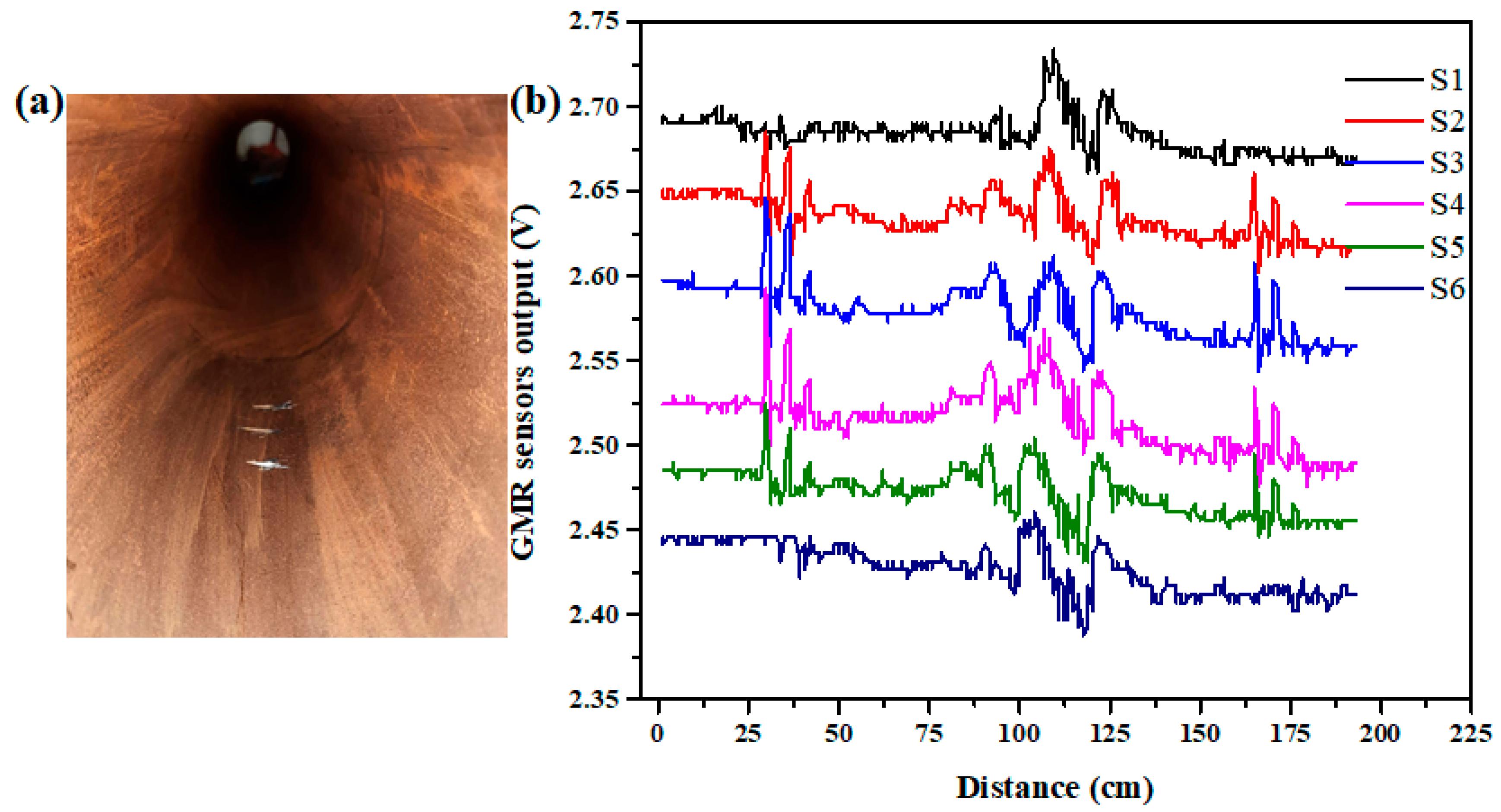
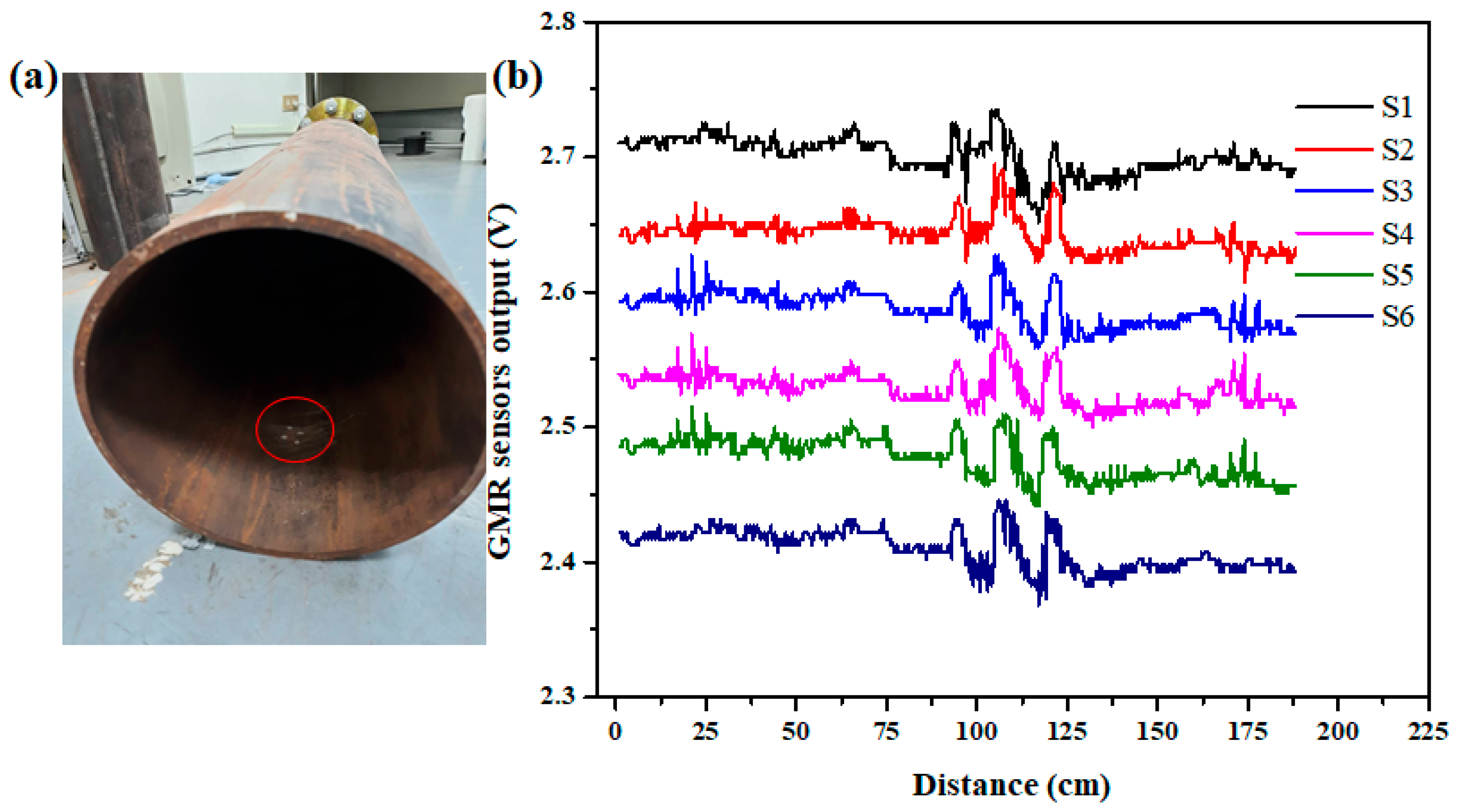
| Specifications | Values |
|---|---|
| Length of the detection unit | 200 mm |
| Length of the power unit | 200 mm |
| Diameter of chassis | 130 mm |
| Chassis size | 85 × 65 mm |
| Full length of pipe | 1900 mm |
| Internal diameter of 6-inch pipe | 159.3 mm |
| Internal Diameter of 8-inch pipe | 206.0 mm |
| Detection wheels diameter | 13 mm |
| Number of supporting wheels for detection unit | 12 |
| Alignment of supporting wheels | 60° |
| Length of spring | 30 mm |
| Spring diameter | 7 mm |
| Sliding rod length | 30 mm |
| Sliding rod diameter | 5 mm |
| Yoke size | 80 × 40 × 14 mm |
| Magnets size | 40 × 20 × 10 mm |
| Magnetic brushes | 40 × 20 × 5 mm |
| Lift of distance | 1 mm |
| Motor wheel diameter | 65 mm |
| Spacing between GMR sensors | 10 mm |
| Defects Type | Defect Size (mm) | SNR (dB) | |
|---|---|---|---|
| 4.5 mm-Thick Pipe | 6.52 mm-Thick Pipe | ||
| Different sizes of the through holes | 2 mm diameter | 12.1 | 9.5 |
| 4 mm diameter | 15.6 | 12.0 | |
| 6 mm diameter | 16.9 | 13.9 | |
| Loss of metallic cross-section (LMA) | 1 mm depth | 12.0 | 9.5 |
| 2 mm depth | 19.0 | 16.9 | |
| 4 mm depth | 20.8 | 19.0 | |
| Uneven multi holes | 6 mm diameter | 13.9 | 12.0 |
| 6 mm diameter | 16.9 | 13.9 | |
| 6 mm diameter | 13.9 | 12.0 | |
Publisher’s Note: MDPI stays neutral with regard to jurisdictional claims in published maps and institutional affiliations. |
© 2022 by the authors. Licensee MDPI, Basel, Switzerland. This article is an open access article distributed under the terms and conditions of the Creative Commons Attribution (CC BY) license (https://creativecommons.org/licenses/by/4.0/).
Share and Cite
Durai, M.; Chi-Chuan, P.; Lan, C.-W.; Chang, H. Analysis of Leakage in a Sustainable Water Pipeline Based on a Magnetic Flux Leakage Technique. Sustainability 2022, 14, 11853. https://doi.org/10.3390/su141911853
Durai M, Chi-Chuan P, Lan C-W, Chang H. Analysis of Leakage in a Sustainable Water Pipeline Based on a Magnetic Flux Leakage Technique. Sustainability. 2022; 14(19):11853. https://doi.org/10.3390/su141911853
Chicago/Turabian StyleDurai, Mathivanan, Peng Chi-Chuan, Chou-Wei Lan, and Ho Chang. 2022. "Analysis of Leakage in a Sustainable Water Pipeline Based on a Magnetic Flux Leakage Technique" Sustainability 14, no. 19: 11853. https://doi.org/10.3390/su141911853
APA StyleDurai, M., Chi-Chuan, P., Lan, C.-W., & Chang, H. (2022). Analysis of Leakage in a Sustainable Water Pipeline Based on a Magnetic Flux Leakage Technique. Sustainability, 14(19), 11853. https://doi.org/10.3390/su141911853







